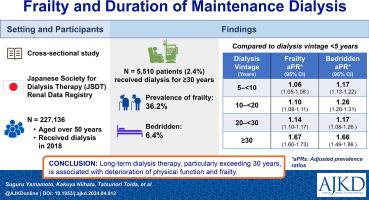当前位置:
X-MOL 学术
›
Am. J. Kidney Dis.
›
论文详情
Our official English website, www.x-mol.net, welcomes your
feedback! (Note: you will need to create a separate account there.)
Frailty and Duration of Maintenance Dialysis: A Japanese Nationwide Cross-Sectional Study
American Journal of Kidney Diseases ( IF 9.4 ) Pub Date : 2024-06-12 , DOI: 10.1053/j.ajkd.2024.04.012 Suguru Yamamoto 1 , Kakuya Niihata 2 , Tatsunori Toida 3 , Masanori Abe 4 , Norio Hanafusa 5 , Noriaki Kurita 6
American Journal of Kidney Diseases ( IF 9.4 ) Pub Date : 2024-06-12 , DOI: 10.1053/j.ajkd.2024.04.012 Suguru Yamamoto 1 , Kakuya Niihata 2 , Tatsunori Toida 3 , Masanori Abe 4 , Norio Hanafusa 5 , Noriaki Kurita 6
Affiliation

|
Prolonged end-stage kidney disease (ESKD) is a risk factor for frailty, and the number of patients in Japan receiving maintenance dialysis for more than 20 years is large and growing. This study characterized the association of dialysis vintage and frailty among patients receiving dialysis in Japan.
中文翻译:

维持透析的虚弱和持续时间:一项日本全国横断面研究
长期终末期肾病 (ESKD) 是虚弱的危险因素,日本接受维持透析超过 20 年的患者人数众多且不断增长。本研究描述了日本接受透析的患者透析年龄和虚弱程度的关联。
更新日期:2024-06-12
中文翻译:

维持透析的虚弱和持续时间:一项日本全国横断面研究
长期终末期肾病 (ESKD) 是虚弱的危险因素,日本接受维持透析超过 20 年的患者人数众多且不断增长。本研究描述了日本接受透析的患者透析年龄和虚弱程度的关联。































 京公网安备 11010802027423号
京公网安备 11010802027423号